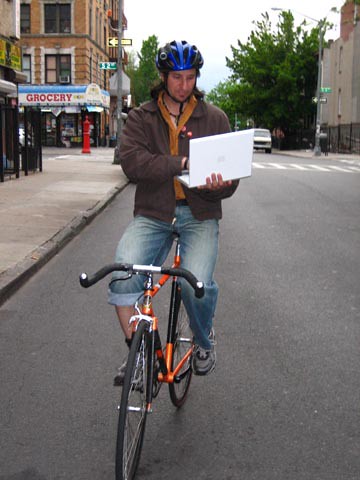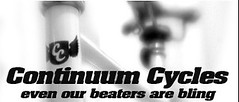Death of a cyclist
Here is an extensive article written by Jefferson Siegel from the New York Villager newspaper.
www.villager.com
A box for collections to help pay for Brandie Bailey's funeral was put out at a memorial for her at CBGB last Sunday night. She was a hardcore punk rock fan.
Cyclist's death is a reminder of the danger on the streets
By Jefferson Siegel
On Sunday night, May 8, Brandie Bailey was able to leave work early. It was near the end of her 2 p.m.-to-midnight shift as a waitress at the Red Bamboo Vegetarian Soul Cafe, a cozy restaurant on W. Fourth St. Manager Jason Wong said they closed just before 11:30 p.m. that night.
"We all said goodnight" he recalled, and like every night, said, "Get home safe." Bailey, 21, got on her red, fixed-gear track bike, a streamlined model with a high seat, no gears and no brakes. A bike commuter, she started pedaling home to her apartment in East Williamsburg. A waitress at the restaurant for a year, Bailey had told co-workers of her plans to fly home to Vancouver in July to visit her mother.
"That's what we were talking about that Sunday night," Wong said, "her vacation."
Just before midnight, Lower East Side resident David Davoli was walking toward Mulberry St. when he saw a crowd at the northeast corner of Houston St. and Avenue A. They were gathered around a bicyclist lying in the street.
"There were three people who, when I arrived, were holding her head and trying to get her to say her name," Davoli said. "She was limp and not responding."
Two doors away, Downtown resident Glenn Pease was having a drink at Julep's Bar on Avenue A when a fire truck roared to a stop.
"I ran over. I went to see who was laying on the floor," he recalled. Brandie Bailey was lying in the crosswalk, just feet from the sidewalk.
The fire truck was soon joined by two police cars and an ambulance. As the tragedy unfolded at the intersection, the private garbage truck that had hit Bailey was heading Uptown. Her red bike lay nearby, its rear wheel bent. Witnesses told police of the hit-and-run and, Davoli said, the police took off in pursuit.
Published reports say the driver was unaware anything had happened. The truck continued north for over a mile, until police finally caught up with it at 21st St. and Second Ave.
Bailey was taken by ambulance to Beth Israel Hospital where she was pronounced dead at 11:58 p.m. She had suffered massive internal injuries. No charges were filed against the driver and no summonses were issued. A Police Department spokesman said the incident was classified as an accident. Drug and alcohol tests on the driver were negative.
Bailey's death has instilled sorrow and incited anger in the bicycle community. Coincidentially, May is Bike Month in the city and this past weekend, devoted riders worldwide had descended on the East Village for the Fifth Annual Bicycle Film Festival. In the crowded lobby of the Anthology Film Archives on Second Ave., many were aware of the tragedy.
At the premiere screening Thursday night, there was a moment of silence in her honor. On Friday night, a Critical Mass ride from Prospect Park in Brooklyn, proceeding across Houston St. to the film fest, stopped at the Avenue A intersection for several minutes. A clutch of flowers was placed near the spot where Bailey fell and several riders raised their bikes over their heads in tribute.
Bicycle awareness and riders anger has increased since last summer's Republican Convention. The monthly Critical Mass rides, which had proceeded unimpeded for years, were suddenly blocked at various locations and riders were arrested en masse. Lost in the furor were the goals the bicyclists were trying to promote: environmentally friendly transportation and safe riding on city streets through the creation of dedicated bike lanes.
When mass arrests didn't stall the monthly rides, the city took the unusual step of filing a lawsuit against four members of Time's Up!, a bike advocacy group. The city claimed the group was organizing illegal gatherings; Time's Up! said they only promoted the rides, as did others.
Bill DiPaola, founder of Time's Up! and one of the defendants named in the suit, was in the Friday night ride. Outside the film fest, he voiced a rider's anger and frustration.
"Every time a bicyclist gets hit in the city, or a pedestrian, no one gets arrested," he said. "This particular truck went for 23 blocks without stopping. If you're not in your car, why shouldn't you be allowed to walk around the streets or to ride your bike, just to feel safe? We feel it's an unfair advantage, and a disturbing advantage to the automobile, that it could scare people, pollute the environment and, in this case, kill someone and get away with it."
By some estimates, 200 pedestrians and cyclists are killed each year in New York City by motor vehicles and thousands more are injured. Of over 6,000 miles of city streets, only 400 miles have either dedicated bike lanes or suggested routes.
In 2003 the city reissued the "NYC Cycling Map" offering a five-borough depiction of bike lanes, recommended routes and suggestions for the "street-smart cyclist." The map shows Houston St. as a "Recommended Route” sufficient width and/or light traffic. Avenue A at that corner has no markings indicating a bike lane. And dotted lines on the map are suggestions that won't protect cyclists or pedestrians from cars speeding to make a traffic light or large trucks making wide turns.
There is an unmarked superhighway between Williamsburg and Lower Manhattan on which countless bicyclists commute daily to jobs, music gigs and the Lower East Side social scene. The Williamsburg Bridge has a designated bike lane, but once a rider exits onto the Downtown streets, they are at the mercy of traffic-clogged thoroughfares.
An example of the deferrential treatment granted to motor vehicles was experienced last month by a Critical Mass participant. Bike rider Nick Caccavale of Brooklyn was trailing behind the ride at 18th St. and Eighth Ave.
"There was a guy [an S.U.V.] squeezing through on the left side and that's where I was, on the left side of the road," Caccavale recalled. He tried to warn the driver off. "He ended up just plowing through me and I fell to the floor. My bike was underneath his car. And he got out, cursing and screaming at me, saying, "What are you doing on the streets, you're a biker, get out of my way, I'm a car."
Police arrived and told the driver to get back in his S.U.V. and leave.
"And they drove away, without taking down any information," the cyclist said.
After walking his damaged bike several blocks, he flagged down a police car and insisted on filing a report.
"They were about to leave me and say there was nothing they could do because there were no witnesses with me and there were no injuries."
In 1999, Charles Komanoff, an economist and activist, published "Killed by Automobile" an in-depth analysis of deaths caused by motor vehicles on New York streets from 1994-1997. While the fatality totals are troubling, the number of people killed by garbage trucks stands out. In those four years, 26 people were killed by the trucks. Of those, 17 were killed by private carters and nine died after being hit by city Sanitation trucks. Komanoff estimates up to 200 pedestrians and cyclists are killed in the city each year by cars and trucks.
"There are too many motor vehicles, they're driven too fast, too recklessly and with too much impunity," Komanoff said."Drivers can drive recklessly and maim and kill with no consequences for themselves."
Davoli has noticed the potentially hazardous driving by the private carters. Just days after Bailey was killed, he was standing on 10th St. and Avenue A and saw a private garbage truck driving like Mario Andretti. This one guy comes down Avenue A going south to turn onto Ninth, going about 30 miles an hour, goes into the left-hand lane to turn right, without slowing down."br />
It's not known if Bailey's bike had lights of if she was wearing a helmet. Track bikes like the one Bailey was riding have long been used by messengers and started to come into vogue about two years ago as messenger chic became cool among cyclists. It's rare that the bikes have front and rear lights for safety, said one bike activist.
"Track bikes usually don't have accessories, like lights; it makes them [the riders] look like a gearhead," he said, using a cyclists term for "nerd."
It's also not clear whether Bailey had been biking against traffic, since she had reportedly been biking south but was found lying on the east side of the avenue and the truck had been driving north.
One thing is certain; an extended community of friends, co-workers and colleagues is mourning an unbearable loss. Some can barely bring themselves to talk about it.
Ryan Moylan lived down the hall from Bailey.
"I can't even picture her not smiling," Moylan said in the lobby of the Bike Film Fest."Just the type of person that everyone liked."
Justin Taylor was a close friend for two years and lived across the street from her.
"She was always smiling," he said. "One of the happiest girls I knew."
Her home page, http://myspace.com/ brandeleen, has been turned into an online memorial with hundreds of expressions of sorrow.
Bailey was a fan of hardcore punk rock music. Her brother, Jason, is the bassist in the Christian metalcore band Figure Four. That's how she met music promoter Rich Hall and became a regular at CBGB. Hall recalled her frequent visits to the East Village club.
"She had ethics, we respected her ethics, she respected ours,†Hall said. Hall organized last Sunday night’s show, which he turned into a memorial to her and collected donations to help her family pay for the funeral. Hall said she would be especially missed by the hardcore community, because the concerts are about meeting people and keeping friendships forever."
Restaurant manager Wong also considered her a friend.
"She was a sweet, sweet girl," he said. "She was as nice as they get, willing to fill in when someone was sick. Helped me out of a couple of jams when I needed someone to host." Wong said she had spent two years at college in Canada before coming to New York. "She was planning on going back. She knew sign language and wanted to open up a sign language business." He paused, then pronounced her,"An angel, this girl."
More are now riding brakeless track bikes
Brandon Neubauer, a member of Time's Up!, said track bikes, like the one Brandie Bailey was riding the night she was killed in a traffic accident on Avenue A, are definitely in vogue, and that in addition to an East Village bike store devoted to the bikes, there is also a popular magazine, called Fixed. He rides one himself.
"It's a big part of the bicycle community, here and in San Francisco and around the world wherever there is a Critical Mass movement," he said. "They were initially made to ride on tracks without brakes. You'd have to know about her bike, some fixed gears have brakes on the front wheel."
There are two ways to stop on a fixed-gear bike. Because the pedals don't coast, but are constantly turning with the wheel, one can either use his or her back leg to resist the turning of the wheel, or push his or her weight onto the front wheel to keep the rear wheel from skidding, with the rider sometimes even standing on the pedals to add to the stopping power.
“You can stop relatively quickly that way," Neubauer said, though adding, In general, fixed-gear riders tend to ride more conservatively because of the limitations of the machine. In my opinion, fixed-gear riders are the best riders in the city.â€
Neubauer said only practiced bikers make the leap from free-wheel bikes to track bikes, and that track bikes offer a purer riding experience because one is really in touch with the machine.
“In my opinion, fixed-gear riders are probably the best riders in the city,†he said.
Lincoln Anderson
Reader Services
thevillager.com
Email our editor
View our previous issues
Report Distribution Problems
Also Read:
ADVERTISING












4 Comments:
the initial report i heard was that she was hit from behind. the fact that her back wheel was bent seems to support this. i could be assuming a lot here, but it seems that to be hit from behind it would be extremely difficult for that to be mainly the cyclist's fault.
what i don't get is how she could be killed by this garbage truck and yet there are no charges? how does "invlountary manslaughter" NOT apply to this? does anyone know more about the qualification of this charge and why it is not applicable? i still find this fact very troubling and frustrating.
Hello,
reading this story brought me to almost tears. You can be a member of so-called civil society, work, pay taxes, vote, blahblahblah. But get on a bicycle and, somehow, we are reduced to second-class citizens.
Here in Australia we're battling all the same bullshit you are with the Eugene McGee case in South Australia. And that's not forgetting Matty Cole, Andrew Watkins and all those fallen victims of an aggressive global road culture.
I've been following the McGee case for awhile & set up a seperate blog to collate discussions & news articles on the case.
http://bicyclejustice.blogspot.com
The anger in Australia's cycling community following McGee acquittal ($3100 fine & 12 months suspended license for a life? WTF?!?!) saw Wheels of Justice protest rides being organised in Adelaide, Melbourne, Brisbane and Sydney. The South Australian government has created the first Royal Commission in ten years to investigate the case.
Brandie was only 21, she had decades of life ahead of her. Don't her death be simply another statistic - in her memory, NY cyclists should fight with grace, guts and dignity to change this appalling inbalance.
Anyway, that's my piece. An injury to one is a injury to all.
A woman is killed, you know nothing about it, but you insist that blame for her must be dug up and printed because "it does all riders a disservice to let the reader infer that she had absolutely no role in the accident?" That's both crass and mental. What on earth is wrong with you?
BTW, "a bike vs. car battle being waged by Critical Mass" is not what this article said, nor is it reality. Clue in.
I agree that there should have been more details in this article. If this is a fixed-gear, brakeless, light-free bike possibly operating against traffic then the cyclist does have some culpability. Cyclists and drivers both have a duty to operate in public responsibly. I think the current fashion for operating fixed bikes in traffic does many riders a disservice. This impetus towards coolness that prevents wearing a helmet or showing lights is similar to the fashion that kept, for instance, Princess Diana from wearing a seatbelt. Hipness or fame are no protection.
Asking for more details and saying the rider might have some role in this accident is not crass and mental. It is the right thing to do. This was an adult; she made choices. If those choices began whittling away at the already-thin safety margins we operate with and it ends badly, it deserves to be pointed out so that those of us still alive can incorporate that information into our own calculus.
I ride with gears, two functioning brakes, two taillights, a headlight, helmet and wariness. Cool I'm not, but I am a live gearhead, nearly fifty, so it's worked so far.
Post a Comment
<< Home